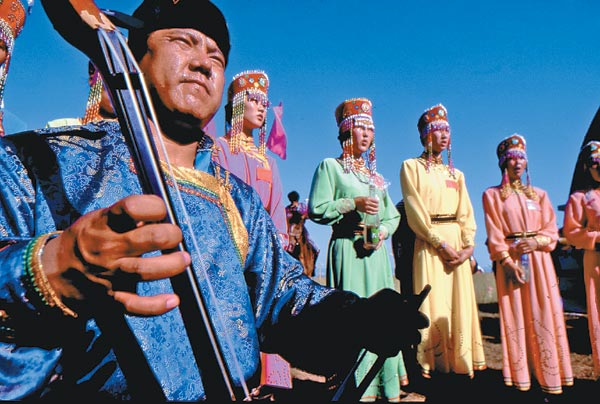Mongolian swan songs
 0 Comment(s)
0 Comment(s) Print
Print E-mail China Daily, November 15, 2013
E-mail China Daily, November 15, 2013
It's a beautiful song known at every campfire around which Mongolians gather. Wang Kaihao looks at the stories behind the Urad ballads, and also the threatened crafts in Bayannur, Inner Mongolia, that are slowly disappearing.
|
Singing has been an indelible part of life for Mongolian people who always have music on their lips and in their hearts. [Photo/China Daily] |
For Mongolians everywhere, the nostalgic lyrics of the Swan Goose ballad is most often sung at the dinner table when it is time to propose a toast.
"When the goblet is empty, make it full again. No one returns home tonight until everyone is happily drunk" - the words best reflect the spirit behind Mongolian hospitality and outlook.
For members of the tribe of Urad, however, the lightheartedness is tinged with the bittersweet, especially in the western city of Bayannur in the Inner Mongolia autonomous region, where the song originated more than 200 years ago.
Narantogos, 68, is a veteran ballad singer living in Urad Middle Banner, a county-level administrative district along the Sino-Mongolian border. Though she moved into town more than 10 years ago, the memories of her home on the great grasslands still haunt her.
"The Urad ballad is rooted in our daily life when we herd sheep," she says. "The lyrics are often impromptu, and flow from our minds. We sing for the grassland and what we see in nature."
As early as the 1940s, Narantogos' mother was already occasionally performing in an arts troupe. She herself made her debut on the professional stage in 1965 in Hohhot, capital of the autonomous region.
She jokingly notes that among her vast family, she is the only one to have inherited her mother's vocal talents.
According to Liu Bin, curator of the Urad Middle Banner Museum, Tibetan Buddhism was once popular among Urad tribe members. About 80 percent of the ballads still being sung today were composed by the lamas in the 17th and 18th century.
Urad ballads were included as a national intangible cultural heritage in 2011 as an extension of the Mongolian ballad.
Narantogos is officially one of three cultural inheritors of the Urad ballads, but she did not seem aware of this until we interviewed her.
Compared to the music of other Mongolian tribes, Urad melodies are more soothing, exemplified by the ballad of the Swan Goose.
"I guess that's probably because we ride camels more, while Mongolians in the east are always galloping on horses," she says with a smile.
In 2008, the banner's cultural bureau helped publish books which recorded traditional ballad scores and lyrics.
Vocalist Sarna is from the bureau, and she is also Narantogos' niece. She admits that the collections depended more on the decision-makers' subjective interests rather than an objective curating.
A ballad competition was held to encourage the effort to preserve the ballads, but Sarna and Narantogos feel this is not enough.
Narantagos is working hard to preserve this heritage in her personal capacity, and she has taken in more than 10 apprentices without charging any money.
She feels that it is urgent, and that she has to pass it on so more young people can learn this genre of music. Already, age is making her voice raspy.
This urgency also applies to other Urad intangible cultural heritage.
Urad means "artisan" in Mongolian, and the tribe has been known for its skilled craftsmen since the days of Genghis Khan. However, this glory is fading fast.







Go to Forum >>0 Comment(s)